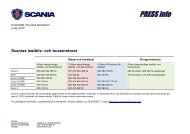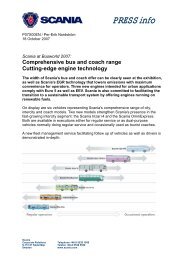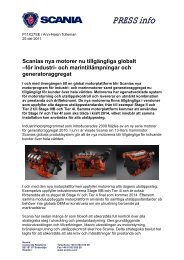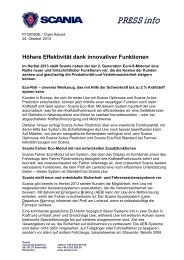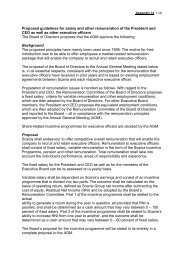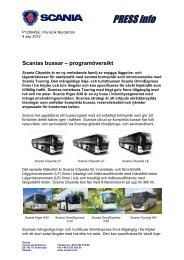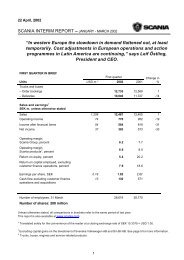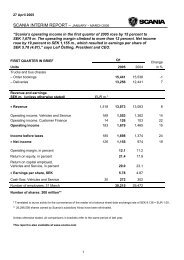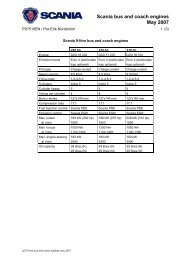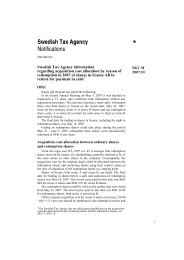Scania Annual Report 2011
Scania Annual Report 2011
Scania Annual Report 2011
Create successful ePaper yourself
Turn your PDF publications into a flip-book with our unique Google optimized e-Paper software.
SCANIA’S SUSTAINABILITY WORK<br />
53<br />
their family members are invited to participate in this<br />
programme.<br />
During <strong>2011</strong>, one of <strong>Scania</strong>’s focus areas was to<br />
improve the health and safety work at <strong>Scania</strong> workshops<br />
and thereby improve the working environment<br />
and well-being of service technicians.<br />
<strong>Scania</strong> also helps promote the health of customers,<br />
and especially their drivers. <strong>Scania</strong> Driver Care is a<br />
programme that has been developed to provide drivers<br />
with advice on health, diet, exercise and working<br />
environment.<br />
Cross-functional working method<br />
The development of working methods occurs crossfunctionally<br />
at <strong>Scania</strong>. Information from workshops<br />
and assembly units – for example such key processes<br />
as the assembly, servicing and repair of brakes – is<br />
shared with product developers. This enables <strong>Scania</strong><br />
to gradually improve the design of products, resulting<br />
in better ergonomics and greater efficiency.<br />
Model workshops disseminate best practice<br />
in safety and ergonomics. These issues play an<br />
important role in updating product units and service<br />
facilities.<br />
<strong>Scania</strong> also endeavours to involve sub-contractors<br />
in its efforts to improve and monitor safety, health and<br />
the environment.<br />
<strong>Scania</strong> Blue Rating evaluations<br />
Evaluation of safety, health and environmental work<br />
is based on several key figures, such as healthy attendance,<br />
accidents, near-accidents and employee<br />
turnover. The <strong>Scania</strong> Blue Rating system is the standardised<br />
method used in such evaluations. Employee<br />
surveys are continuously conducted to monitor how<br />
employees perceive their working situation and relationship<br />
Medarbetare<br />
to <strong>Scania</strong>.<br />
– frisknärvaro globalt ENG<br />
Medarbetare – Åldersfördelning<br />
One of China’s first schools for<br />
training service technicians<br />
A major challenge for <strong>Scania</strong> in China<br />
has been the absence of any standardised<br />
training programme for heavy<br />
vehicle service technicians. To ensure<br />
a supply of service technicians with<br />
good knowledge of <strong>Scania</strong> vehicles,<br />
in <strong>2011</strong> <strong>Scania</strong> initiated a partnership<br />
with the Guangzhou Institute of Technology,<br />
which has 10,000 students, to<br />
jointly develop and run a <strong>Scania</strong>-branded<br />
training programme for heavy vehicle<br />
service technicians – the Dragon School<br />
Project.<br />
Medarbetare – Utbildningsnivå<br />
Inauguration of the Dragon School in China.<br />
The school was inaugurated on<br />
12 October <strong>2011</strong> and is one of the first<br />
schools in China for training heavy<br />
vehicle service technicians. To <strong>Scania</strong>,<br />
this is a very important part of building<br />
a good reputation both as a vehicle<br />
manufacturer and as an attractive<br />
employer.<br />
The programme runs for six terms,<br />
the last of which is a practical training<br />
term at <strong>Scania</strong>. This is a way of ensuring<br />
a good knowledge of <strong>Scania</strong> vehicles<br />
among the students.<br />
Global healthy attendance<br />
Age distribution<br />
Educational level<br />
Medarbetare Female managers, – kvinnliga 2006–<strong>2011</strong> chefer ENG<br />
%<br />
100<br />
75<br />
50<br />
25<br />
0<br />
Production<br />
units<br />
96.3 96.3 97.2 97.5<br />
10<br />
11<br />
Sales and services<br />
operations<br />
10<br />
11<br />
60–<br />
55–59<br />
50–54<br />
45– 49<br />
40– 44<br />
35–39<br />
30–34<br />
25–29<br />
20–24<br />
–19<br />
4 %<br />
7 %<br />
9 %<br />
12 %<br />
14 %<br />
15 %<br />
14 %<br />
14 %<br />
8 %<br />
3 %<br />
Post-secondary<br />
education<br />
30.6 %<br />
Compulsory school<br />
not completed 1.7 %<br />
Compulsory<br />
school<br />
14.6 %<br />
Secondary school 53.1 %<br />
Sweden<br />
15%<br />
21%<br />
Globally<br />
11%<br />
16%<br />
06 11 06 11<br />
Global healthy attendance among employees<br />
at <strong>Scania</strong>’s production units remained<br />
at the same level as in 2010. In sales and<br />
service operations, healthy attendance rose<br />
by 0.3 percentage points.<br />
The age distribution among <strong>Scania</strong>’s<br />
employees is well-balanced, and<br />
remained at the same level as in 2010.<br />
<strong>Scania</strong>’s employees have a high<br />
level of education.<br />
At the end of <strong>2011</strong>, 21 percent of managers<br />
and 21.5 percent of employees were<br />
women in <strong>Scania</strong>’s Swedish operations.<br />
Globally 15.5 percent of managers and<br />
16.5 of employees were women.<br />
<strong>Report</strong> of the directors <strong>Scania</strong> <strong>2011</strong>



